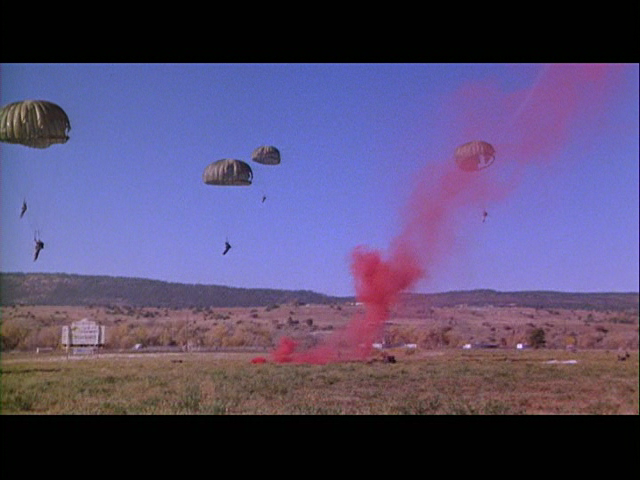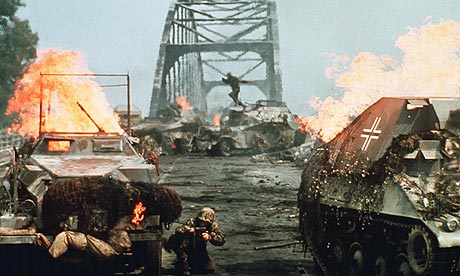So You Want to Kill Russians?
 •
by
•
by Cromstar
Good for you!
It’s not just a fun thing to do, it’s your patriotic duty as
a citizen of the eUSA! And don’t feel bad for the Russians, either…they hateapple pie, and have insulting things to say about your mother. I can’tbelieve how low those fellows will go!

So now that you know what you want to do, you need to get
down to business! Unfortunately, while it may be fun to ride around in yourtank or helicopter and blow Russians up on the battlefield, that doesn’t alwayshelp the eUSA win the war.
You can’t just fight, you have to fight smart.

After you’ve picked your weapon and stepped onto the
battlefield to gun down a few members of the Red Menace, you have to askyourself, “How can I help the eUS win this battle?”

First off, you should seriously consider joining up with
the eUS military (or a militia if you swing that way). In addition to thefun of being a member of some of the most kick-ass organizations in eRepublik,they provide better instructions on how, when, and where to fight, plus theyhelp provide you with cheap/free weapons, moving tickets, and other suppliesyou need to be effective. If you already are in a militia or the military, youshould contact your superior in the chain-of-command for instructions.
If you aren’t in any of those organizations, or you are, but
you’ve been told to cut loose, don’t just go blasting Ruskies all willy-nilly!That does NOT help win battles most of the time.

Despite his best efforts, Rambo didn’t save Oregon from Russia because he doesn’t know
enough about battlefield tactics. So, learn from Rambo’s mistakes, and learnsome strategy!
Remember reading all that stuff admins talked about in their
articles? Well, whether or not you do, here’s a reminder: there are twoconditions to winning a battle. One side must complete both conditions towin the battle.
1. Hold the Capital city of the region.
2. Possess at least 75% of the tiles in a region.
If neither side has completed both objectives at the end of
the 24 hour period for a battle, it enters into overtime…and that means thefirst side to complete both conditions at the same time wins automatically.
So what does this mean for you?

Well, due to the way the new war module works, it means that
the beginnings of most battles hold very little meaning on the outcome of thefight. In fact, we’ll go so far as to say that, unless the Department of DefenseOrders say otherwise, don’t fight in the first day of any particular battle.
Sadly, after you go to bed that night, the OTHER side will
wake up in the morning and undo all your progress when you aren’t around tostop them. What does that mean? It means you probably wasted health, time,weapons, and money and got nothing to show for it.
However, during the second day of a battle, people begin to
act, in the hopes of completing the conditions and winning the battle for theirside! Now’s your chance to act, and you should know what to do!
Russians, Russians, everywhere, and not a friend in sight?

That will probably happen sometimes. In those cases, you
might end up getting attacked by a dozen enemies and end up dead. Remember, youaren’t superman! Even a Field Marshall and a Veteran with a Q5 weapon willeventually be brought down by enough Russians. You want to take them downwithout being taken down yourself.
Basic tactics

Remember the terrain bonuses and use them to your advantage
for both offense and defense. Infantry, stick to forests and mountains,especially when facing tanks (they will just run you over if you catch them inthe hills where they have the terrain bonus!) Don’t forget your unit bonuseseither infantry! Whenever you spot an enemy artillery defending a city, bridge,or just out in the open, you can move in on him. He’ll have the defense bonusin a city tile, but anywhere else, you can just destroy that artillery and freethe ground for friendly helios to join the fight at your side.
Tanks, just remember to run over any infantry you can find.
You can’t chase them into the mountains, but if you get into the hills and getthe terrain bonus for yourself, your unit bonus will give you that much of anedge to destroy them. You’ve got 2 movement points each turn, an advantage overinfantry and artillery, so use them well to cover ground fast if you need toget somewhere in a hurry. Just be sure to watch out for helicopters…especiallyon open ground.
Helicopters, you have most useful functions in a battle. In
addition to 3 movement points, you can cross ANY terrain, a huge bonus overevery other unit. In fact, water tiles can only be captured by helicopters, andyou are the only unit that isn’t affected by bridge blockades. Use yourmovement to benefit your allies, by helping to get around behind blockades atstrategic locations, crossing rivers where there aren’t any enemy units,sneaking into the backfield to capture tiles unopposed, or just bearing down ona tank and blowing it to pieces.
Artillery, you have an extremely important role to play.
Helicopters are extremely versatile units that can cause a lot of problems ifleft unchecked. Luckily, you have the advantage over them…oh, and you have anadvantage when in a city. Gee…regional capitals are cities. That makesartillery perfect for defending capitals…especially against rouge helios thatjust fly over a river to avoid the defenses at bridgeheads!
No, I’m afraid that isn’t all there is.
Remember, just remembering the basics about unit strengths
and bonuses only gets you so far…you need to know a bit more about tactics onthe battlefield in order to best help the eUSA.
Here’s the nitty-gritty detail. Things the experts know but
you might not. Learn them by heart.
Deployment

Where you deploy on the map is important in a battle. If you
didn’t deploy in the first day of the battle and waited until the second,you’ll have the extra luxury of deploying most anywhere on the map your alliesstill control. That’s another reason to wait on joining a battle…after you’vejoined the battle once, you are limited in where you are allowed to deploy to thebattlefield.
Oh, and while you should carefully consider where to deploy,
you should also remember that deployment is important to the other side as well.Remember that.
So where to deploy? Generally speaking, deploying for the
first time leaves you with 4 main options you might run into you.
If either side owns the entire map, you pretty much have a
choice of where to deploy…along the front line of the deployment zone. If yourside owns the map, you should deploy along the enemy’s deployment zone and helpkeep them from breaking out. If the enemy owns the map, deploy in your owndeployment zone and help your allies to break out.
If the battle is particular close or tight, there’s likely
to be large zones controlled by one side or the other. If there is fightingaround the capital of a region, and you can deploy nearby, that might be a goodidea, so that you can join in on the attack or defense of the capital,depending on who owns it.
Sometimes, when you go to deploy, you’ll notice that there’s
a major front where both sides are stacked up heavily. If there’s only that onefront, you can choose where to deploy and do your best to break the enemy’slines and secure the battle for your side.
Finally, sometimes you might get lucky and your allies will
have taken a large zone behind the enemy lines. Deploying in these zones toattack the enemy and capture tiles behind his lines, where he’s weak andusually has few units, can really help your allies. It not only pushes towardsthe tile-holding victory condition, but it also draws fighters away from thefront lines of battle, forcing the enemy to lose ground if he’s not careful andtoo many people leave the front.
Tiles versus Fights

Everyone wants to kill the enemy. We all know that. However,
killing the enemy doesn’t actually win the battle. It’s controlling tiles.
Sometimes you’ll want to jump into the fight and blow some
stuff up. However, you might be more useful performing the dull job ofcapturing tiles. It might not sound as glamorous as fighting the enemy up-closeand personal, but it often has a bigger impact on the battle itself.
Remember how important deployment zones are? Remember when
we mentioned deploying in the backfield to cause trouble for the enemy? Well,the enemy can do the same to you!
So if you happen to be nearby a cluster of enemy tiles, and
they are behind the main front of a battle, quickly capture them so the enemycan’t deploy there! The last thing you and your friends want is for a dozenField Marshall’s to appear right beside the capital because you were too busychasing the enemy away to capture the tiles. If there’s any form of breach inthe front where a helicopter popped across a river, or a clump of tiles wheresome tough guys made their last stand, then please help capture those tilesbefore getting back into the fight.
Capturing tiles and cutting off enemy deployments can turn
the tide of battle! And remember, you need 75% of the tiles to win the battle…ifyour side only needs those last few tiles, these ones are easier to pick upthan the ones the enemy is currently sitting on.
Bridges and rivers

Three of the four unit types are blocked by rivers and require
a bridge to cross. So naturally, rivers form strong barriers against all but helios,and bridges become very important in the long run. When it comes to attackingor defending rivers, everyone needs to pull together to do it right!
Tanks and infantry, being limited to land, have only one
real option: take the bridges! Tanks and infantry serve as the backbone of anysuccessful attack or defense of a bridge crossing a river. You need to pileonto the bridge and surrounding tiles, push back enemy attacks on yourpositions, and try and dislodge the enemy from their own positions. Onceyou’ve secured the bridge, everyone should be moving across it and into thetiles on the other side of the bridge. Don’t get caught up in just holdingthe bridge tile, when you can use the terrain on the far side to increase yourdefensive advantage!
Helicopters also play an important role in river-crossing,
since they aren’t limited to the bridge. While some helicopters should assistat the bridge itself, still others should find undefended parts of the riverto cross and enter the enemy’s territory, dragging vital resources awayfrom the bridge AND capturing tiles for your side. Remember, helicopters have along range (3 moves per turn) and you can easily out run the enemy and forcehim to chase you around.
Artillery have as big a role in defending rivers as
helicopters do in assaulting them. In fact, it’s because helicopters have suchan important role in crossing rivers. Artillery should spread themselves outalong the entire length of a river bank and prevent enemy helios fromcrossing the river. If you don’t, they enemy can circumvent any defense at thebridge and weaken your allies.
Defending the capital

We cannot stress this enough, so we’re going to make it big
and bold so you don’t miss it.
DO NOT JUST PILE INTO THE CAPITAL CITY TILE AND
HOPE TO KEEP THE ENEMY FROM TAKING IT.
Did you catch that? Good…means we don’t have to say it
again. But we are anyway.
DO NOT sit on the capital tile and assume you are doing a
good job. You are NOT.
In fact, with a few exceptions, the only units that should
be camped out on the capital tile itself are artillery, since they have a defensebonus in cities. Everyone else should make positive use of the terrainaround the capital to increase the defenses of the capital. Check theterrain and look at where the enemy units are coming from.
Are helicopters crossing a nearby river to attack? Some
artillery should take up positions along the river or just wait at the capitalto shoot them down. There’s not much point in tanks sitting between them, onlyto get shredded by helios.
Nearby bridge head providing the only land access to the capital?
Then all the tanks and infantry should be on the land between the capital andthe bridge, and pushing to take that bridge and cripple the enemy assault.
Does the capital sit in the middle of ground, with no near
by rivers? The enemy can come in from everywhere? Then use the terrain toyour advantage! If there are nearby mountains and forests, the infantryshould be piled up knee deep in there, using the terrain bonus to attack enemyunits from the cover. Helicopters should zoom around the open plains, attackingthe enemy and avoiding slow-moving artillery. Tanks should find any hills ifthey can…and if they can’t, they should concentrate on preventing enemyinfantry from entering the forests or mountains. Catch the infantry in the openbefore they can make it to the forest and destroy them that much easier.
Closing thoughts
So you want to kill Russians?
Good to hear. And remember…killing Russians just isn’t
enough. We want to win the war as well! Hopefully you’ll remember the lessonswe’ve taught you today, and put them to use on the field tomorrow!
And don’t forget, ladies, gentlemen, and whatever the rest
of you are, if you aren’t sure what to do, the eUS Department of Defense has apublic IRC channel where you can come and ask for advice on where and how tofight! Join us in the Rizon channel #defense where all your questions will beanswered.
Now, on to victory!



Comments
Cromstar!
This message is approved by the Department of Defense, Department of Education, the President of the eUSA, and the Chairman of the Joint Chiefs of Staff. \o/
Solid article! I wouldn't expect anything less from Cromstar the Great though.
Wow. This is an insane article.
Voted, already subed.
Wow.
This is a great, great, great article!
Well said!
Very Useful
voted and subbed.
or you can just give you country to ePoland 🙂
Great.
Very good read. Voted.
This article was definitely needed! Great job!
Good article!
v+s
voted
That was actually a very good article. V+S
I'll read the rest later. Very nice.
I stand ready to kill Rubots.
No we dont, douchebag.
LOL!!! FAIL!!! MOTHER RUSSIA WILL DESTROY YOU!!!
HAIL SERBIA!
Voted and subscribed! Verry good article!
Approved by ND. Kill the eRussians 🙂
voted 🙂
Glad I could help proofread 😃
Nice!
tl;dr
Excellent article!
Voted.
To late for me to read it all, but I love the pictures
Awesome! More stuff in one place than anywhere else. Thanks, 'Art'bro.
Nice article. Sorry if I'm fighting on the Russian side, though 😛
sosite hui ruskie. Vy tolico umeete piti i vy siliniye toliko s bandoy.
A v odino4ke vy nicto. Dead Russia!!!
Cool story, bro!Enjoy your vodka :>
Fascinating read. Particularly since we can read it too.
I particularly like all the battlefield advice that I will be sure to exploit the next time I fight.
Against you.
fail fail fail
remembr pls. losers 😛
Thanks!
I do and eSwitzerland need your help 😃
I do and eSwitzerland need your help 😃
I want to kill yanks!
You guys actually needed an article like this ?
AND you keep calling it GREAT ? 😮
wow..
Awesome Fail
too bad we're killing you.
Be prepared to start drinking vodka, playing troika, and dancing with bears.
Great article, Cromstar!
Hail USA clickers.... this game is the worst nightmare of USA seriously... Most of your players just click and that's bad :/
what a nonsense! we like apple pies
A helpful article.
I've been in a dozen fights but never really thought about the importance of my Heli going deep behind enemy lines, distracting Artillery, and so on. I think my effectiveness and enjoyment of the WarMod will improve now. 🙂
Now, on to victory! So, I just do it, as you say: http://www.erepublik.com/en/article/-1-1471786/1/20">http://www.erepublik.com/en/article/-1-1[..]/1/20
поздравлаем з ПолшЬы 🙂
V&S from Poland
how to kill americans?
Amazing Article Cromstar! We need this.